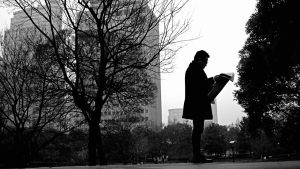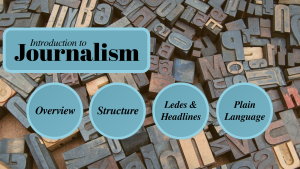38 Journalism Overview
Learning Objectives
-
Explore concepts about the study of Journalism. Understand how practice of Journalism skills can improve your writing.
-
Explore careers in a sector that is in-demand. Understand what program pathways lead to those careers.
Chapter & Discussion
This chapter includes a presentation that can be navigated in a classroom setting or independently. You can access the presentation via the link below.
Work through the different sections of the chapter and discuss ideas and topics as they arise. If you’re working independently, take notes instead. Notes and active discussion will be helpful in navigating this week’s assignments.
Overview
Journalism is the process of gathering information about current events, issues, and topics that are relevant to society, verifying facts, and presenting that information accurately and fairly to the people.
- Journalists serve the important roles of:
- Keeping citizens informed
- Holding institutions accountable
- Giving people the factual information they need to make decisions and stay current
Journalists are writers who are trusted to investigate what’s happening in the world and to report the facts to the people.

In This Unit
The goal of this unit is to practice your professional writing skills by exploring fundamentals of news media. Through examining principles of journalism, this course strengthens skills critical for success in any field—conducting thorough research, carrying out engaging interviews, writing clearly, evaluating sources accurately, and presenting information responsibly.
We will analyze elements of impactful stories, discuss ethics and best practices of journalism, and get hands-on practice with reporting tools to build communication confidence. By studying standards around compelling writing, factual credibility, and audience relevance, we’ll practice the process of simplifying complex issues, telling stories powerfully, and sticking to the facts when sharing writing.
Structure
News articles are written in a form called the inverted pyramid structure: where the broadest, most critical information appears first in the article, and less important information follows.
It starts with the lede: a short paragraph conveying the essence of the news event and key details.
The nut graph follows, elaborating background essential to comprehend the news significance.
Supporting facts, statistics, geographic factors, quotes, and additional details narrow as the story progresses down the pyramid. These facts provide evidence for the claims made in the opening.

Ledes and Headlines
The headline of a story appears at the top. Its goal is to share the most important details in a very concise way. Journalists also use headlines to get the attention of the readers. The lede will follow, giving us a more detailed picture of the story.
Together, the headline and the lead give us enough information to understand the story (but with no evidence).
This format (say the thing, then go deeper) is important to all writing. It helps us practice determining what information is most important to the reader, and how to follow up with details.
Plain Language
Journalists try to report the news in clear writing everyone can understand. Here are a few of the rules they follow to do so:
- Avoid fancy words and tangled sentences.
- Write straight-forwardly so all kinds of readers grasp your story accurately.
- Keep it simple but still grab attention.
- Make each detail tell what readers need to know about this event or issue.
Plain writing respects readers’ time and intelligence – it’s helping people understand, not showing off. Clarity, honesty and purpose-driven writing serve journalism best.
Assigned Reading
Here are this week’s readings. Additionally, please read for your own personal enjoyment for 1/2 hour each day. This will be called your “Reading Zone” reading and it will coincide with many upcoming activities.
How to Choose Your News by Damon Brown (via TED Ed)
Problem Set: Practice Your Skills!
Click here to complete a ten-question problem set on concepts in this chapter.
Completing problem sets like this can be an important element of independent study towards completing your HSE. I write these to resemble the style of questions you’ll find on the Reading and Language Arts GED.
Assignment: How to Choose Your News (250 Words)
Watch How to Choose Your News by Damon Brown and Ted Ed, and explore the materials available. Then, create a discussion post that answers the following prompt:
How do you get your news? Are there sources that you are exposed to that make you skeptical? How do you decide what sources to trust?
Assignment: Reading Zone Response (250 Words)
For Reading Zone, you must find a novel that is interesting to you and enjoyable to read. If you need help finding a Reading Zone book, please ask. Please read your Reading Zone book for a half-hour each day. On class days, there will be time in class dedicated to reading.
Create a two-paragraph response to the reading you did this week. The first paragraph should summarize what you read this week. The second paragraph should address the following prompt:
Imagine you are writing the theatrical trailer for a movie version of your book. Based on what you know so far, write the narration for this trailer.


